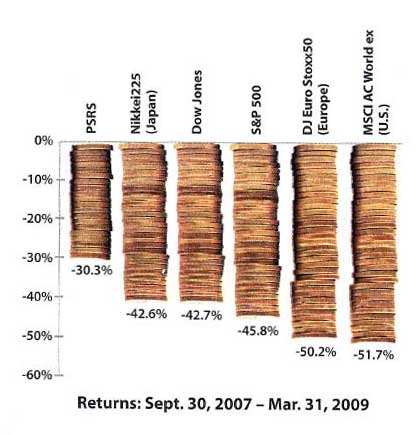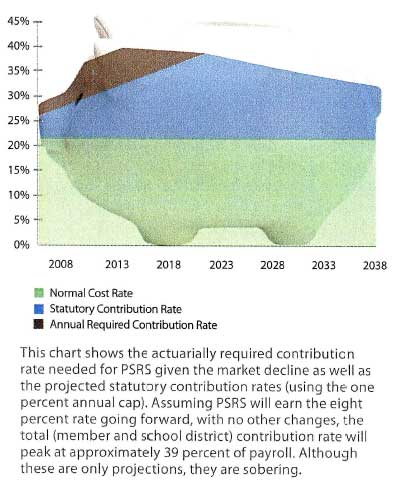Roeder Financial .com - Where Vision Meets Reality

More Information:
Roeder Financial
4532 Westview Drive, Suite 100
La Mesa, CA 91941-6433
(619) 300-8500
The Current Economic Downturn and PSRS
M. Steve Yoakum,
Executive Director of the Missouri Public Schools Retirement System May 6, 2009
Reprinted by permission from the
Missouri National Education Association newsletter Summer 2009
where it had the title "Your retirement - How safe is it?"
There hasn’t been an event that has created more questions and concern than the current economic downturn. As you might expect, since this downturn began the Public School Retirement System of Missouri (PSRS) has fielded numerous questions from members, retirees, taxpayers and others concerning the possible effects of the market decline on the System.

Economic
Downturn
Since the U.S. stock market began declining in
October 2007, the decline has rivaled a similar period -- the Great
Depression. From October 2007 through March 2009, the U.S. stock
market has declined 45.8 percent, while Europe has seen a 50.2
percent decline and Japan a 42.6 percent decline. It has truly been a
worldwide economic slowdown with few places to hide.
PSRS, utilizing a professionally managed investment program and a well-diversified portfolio, fared significantly better over the same time period declining 30.3 percent. While the System has outperformed most markets and the majority of similar institutional investors, we have still experienced a substantial decline in asset values over this difficult period. This decline does not impact our ability to provide the benefits promised, but it will have an effect on the funded status of the plan and future contribution rates.
Fortunately, PSRS entered this downturn in good financial condition with a strong prefunded ratio of over 83 percent. Also, as the largest institutional investor in the State of Missouri, and one of the largest in the nation, the System has seen the ebbs and flows of investment markets and has positioned itself as a long-term investor. However, investment declines of this magnitude ultimately have an effect.
Assets and
Liabilities Annually Reviewed
Each fiscal year (July 1-June
30), the PSRS actuaries compare the assets and liabilities of the
System to determine the funded status and contributions necessary for
the future. With each year of service earned by Missouri’s
educators, the promises (i.e. liabilities) of the plan increase, as
hopefully do the assets. When measured over time, this comparison of
assets and liabilities results in the prefunded ratio. As of June 30,
2008, PSRS was 83.4 percent prefunded. Stated another way, PSRS had
over 83 cents of each dollar of future benefit promises made to
Missouri’s educators -- a very healthy position.
As complicated as a fund like PSRS can be, there are really only three “levers” that affect the funding levels of a defined benefit retirement plan like PSRS:
Benefit Promises
Investment Earnings
Contribution Rates
Benefit Promises
Unlike a Defined Contribution (DC) plan (e.g. 401k, 403b) which
provides benefits based on account balances, PSRS is a “Defined
Benefit” (DB) retirement plan and provides benefits based on a
formula using a member’s final average salary and years of
service. These benefit promises for PSRS members are made by the
Missouri General Assembly and codified in state statute. The benefit
provisions of PSRS such as retirement ages, eligibility, benefit
levels and cost-of-living adjustments are all established and
controlled by state law. The PSRS Board of Trustees and staff do not
set these benefits but instead administer them. Any reduction in
benefit levels or promises would have to be passed by the Missouri
legislature and signed into law by the Governor. Unlike many other
states, there have been no bills introduced or any pending before the
Missouri General Assembly to make any benefit cuts.
Article I, Section 13 of the Missouri Constitution and the attendant case law makes the argument that the relationship between PSRS and the members of the plan is contractual in nature and the benefits may not be diminished or impaired. While changes in benefits and plan design cannot be completely ruled out in the future, this Constitutional provision makes it difficult.
Investment
Earnings
This is the most important lever of the three because
investment income accounts for almost 2/3 of the revenue needed to
fund the retirement benefits for Missouri’s educators. The
remaining 1/3 is split almost evenly between member and school
district contributions. Our actuaries, to establish contribution
rates needed to adequately fund those benefit promises, must make
assumptions about how much money we expect to earn on our investments
in the future. As with most similar retirement funds, PSRS’
return assumption has been 8 percent for many years. In years when
the System exceeds the 8 percent return, actuarial gains are incurred
and the funded status improves. Conversely, in periods like this when
the 8 percent assumption is not met, the actuarial losses result in a
decline of the funded status.
In order to lessen the volatility in liabilities and contribution rates, PSRS actuaries use a five-year smoothing period to value gains and losses in the investment portfolio for funding purposes. Still, with historically low investment returns in 2008 and that trend continuing in 2009, these declines will ultimately be considered by the actuaries in the funding and establishment of future contribution rates for members and school districts.
Contribution
Rates
Once the benefits are set and the investment return is
known, the actuaries will calculate the contribution rate required to
fund those benefit promises. Missouri law requires the actuaries to
annually compare assets and liabilities and develop contribution
rates. The law also limits any change in
contribution rates to 1 percent per year (1/2 percent each to the
member and the district). The current PSRS member and district
contribution rate is 13 percent and will increase to 13.5 percent on
July 1, 2009.
The actuaries must make numerous assumptions about demographics, life expectancies, retirement patterns, and most importantly, future investment returns, to determine the contribution rates needed to adequately fund the plan in the future.
As noted earlier, PSRS uses an 8 percent assumed rate of return on investments for funding purposes. The investment market volatility we have experienced lately makes future contribution rate projections difficult. Even when investment gains and losses are ‘smoothed’ over five years as done by PSRS, future contribution rates are greatly determined by investment returns.
 Projection of
Future Contribution Rates
Projection of
Future Contribution Rates
Because the investment returns have
such a powerful effect on the funded status and contribution rates,
it is difficult to project them far into the future with a high
degree of accuracy. However, we have asked the actuaries to project
the estimated future contribution rates needed for PSRS using the
following parameters:
No change in benefit levels, patterns or provisions
Investment return of -20 percent for FY 2009
Investment return at a rate of +8 percent for all years in the future beginning
FY2010.
Future
The
PSRS Board of Trustees is collaborating with MNEA and other Missouri
educational associations to ensure all parties are informed and
educated about the market conditions and how they affect the System.
Together we are working to identify financial solutions to safeguard
the stability of the System. So what does this all mean?
The recent drop in investment markets is substantial and is a concern worldwide.
We are long-term investors with a focus on providing a secure retirement for future generations of Missouri educators. From a historical perspective, we feel confident the market’s peaks and valleys will balance out in the long term.
PSRS assets are invested in such a way as to meet cash and benefit requirements, while also being able to participate in market recovery as it happens.
Negative investment returns have a direct and substantial impact on future contribution rates.
Contribution rates are expected to increase for several years in the future; how long will be determined by future investment returns.
The PSRS Board of Trustees and staff are working to ensure that future generations of Missouri’s teachers and support staff will inherit a retirement system as strong and reliable as the one we have today.
Guest authors are
welcome to submit articles and their thoughts to the ROEDER RAMBLE
for potential viewing on this site.
Copyright © 2009 & beyond by Roeder Financial, all rights reserved.
Site created by
Open Sky Web Design using a template design by Nadia